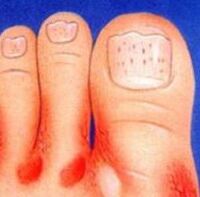According to statistics, every tenth of our planet suffers from the fungus of the legs or, as it is also called, epidermophitosis. Most often, men suffer from this disease, which is more due to the characteristics of physiology, but the fact that male representatives are more frequent and longer than women wear closed shoes.
The disease can be provoked for one of the following reasons: Foot fungus can be manifested in different ways: The exact determination of the type of fungi that impressed the feet will help to choose the right treatment of this disease. In medicine, it is customary to separate 3 main types of fungi: membrane, such as moccasin, vesicular. And each of them is inherent in both common and characteristic symptoms. Signs of a membrane fungus: The fungus on the legs of the type of moccasin are different from the rest: The vesicular fungus is characterized by: blisters filled with fluid and localization at the bottom of the foot. Foot fungus: diagnostics The diagnosis of a "leg fungus" is made by a dermatologist based on the patient's examination. More detailed studies: scrap, skin biopsy, cultivation - will help the doctor as accurately determine the type of fungi that impressed the patient. In addition to everything, the doctor conducts a patient study to manifest this disease in the past. The latter is particularly important, as often recurrent manifestations of fungi for a certain period of time signal the transition of the disease to a more severe form, which is more difficult to treat. Foot fungus therapy does not require stationary monitoring and is performed on an outpatient basis. In most cases, external antifungal drugs are prescribed to the patient. It is worth noting that often people suffering from the fungus of the foot do not turn to a specialist at all, limited to taking medicines sold at a pharmacy without a prescription. This scenario quite often leads to a favorable result of the disease. However, it should be remembered that prolonged therapy of the disease, accompanied by worsening in the condition of the legs, shows the advanced stage of the disease. The best way out of this situation will be to visit a specialist who will help you choose the optimal fungus medicine.



























